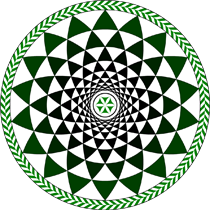Speaker
Mr
Wojciech Tomczyk
(Marian Smoluchowski Institute of Physics, Jagiellonian University, prof. S. Łojasiewicza 11 Street, 30-348 Kraków)
Description
`A newly observed – heliconical (twist–bend) nematic phase (NTB) of nanoscale pitch [1] has recently caught much of attention. Initially, the theoretical concept of this phase has been presented by R. B. Meyer [2] in 1973, where he assumed that the director of the molecules precesses on a cone forming an oblique helicoidal structure. Subsequently in 2001 Dozov [3], in 2002 Memmer [4] and in 2004 Lorman et al. [5], suggested that the formation of the N$_\mathrm{TB}$ can be facilitated by the shape of bent–core molecules.`
`Here we present theoretical investigations on relation between biaxiality and bend angle on stability of nematic twist–bend phase. We use a generalized Maier–Saupe type of model for NTB [6], with intrinsic molecular biaxiality on both of the arms of the molecule, quantified by a $3\times 3$ second–rank traceless symmetric tensor $\mathbf{Q}$. Values of bend angle ranging from 130 to 170 degree were investigated. The detailed results show the influence of the molecular biaxiality parameter [7] on the relative stability of the NTB, nematic, isotropic phase and the related phase transitions. For the bend angles equal or larger than 140 degree we observe all five possible phases: uniaxial and biaxial twist–bend nematics, together with uniaxial and biaxial nematics and isotropic phase.`
`Acknowledgments`
`This work was supported by Grant No. DEC–2013/11/B/ST3/04247 of the National Science Centre in Poland and in part by PL–Grid Infrastructure. W. T. acknowledges support from Marian Smoluchowski Scholarship (KNOW/58/SS/WT/2016) granted by Marian Smoluchowski Cracow Scientific Consortium “Matter–Energy–Future” within the KNOW funding.`
`References`
[1] V. Borshch, Y-K Kim, J. Xiang, M. Gao, A. Jakli, V. P. Panov, J. K. Vij, C. T. Imrie, M-G. Tamba, G. H. Mehl and O. D. Lavrentovich, `$\textit{Nature Communications}$` `$\textbf{4}$`, 2635 (2013).
[2] R. B. Meyer, “Structural Problems in Liquid Crystal Physics”, pp. 273-373 in Les Houches Summer School in Theoretical Physics, 1973. Molecular Fluids, R. Balian and G. Weil (eds.) (Gordon and Breach, New York, 1976).
[3] I. Dozov, `$\textit{EPL (Europhysics Letters)}$` `$\textbf{56}$`, 247 (2001).
[4] R. Memmer, `$\textit{Liq. Cryst.}$` `$\textbf{29}$`, 483 (2002).
[5] V. L. Lorman and B. Mettout, `$\textit{Phys. Rev. E}$` `$\textbf{69}$`, 061710 (2004).
[6] W. Tomczyk, G. Pająk, and L. Longa, `$\textit{Soft Matter}$` `$\textbf{12}$`, 7445 (2016).
[7] R. Berardi, L. Muccioli, S. Orlandi, M. Ricci, and C. Zannoni, `$\textit{J. Phys.: Condens. Matter}$` `$\textbf{20}$`, 463101.1 (2008).
Author
Mr
Wojciech Tomczyk
(Marian Smoluchowski Institute of Physics, Jagiellonian University, prof. S. Łojasiewicza 11 Street, 30-348 Kraków)
Co-authors
Dr
Grzegorz Pająk
(Marian Smoluchowski Institute of Physics, Jagiellonian University, prof. S. Łojasiewicza 11 Street, 30-348 Kraków)
Prof.
Lech Longa
(Marian Smoluchowski Institute of Physics, Jagiellonian University, prof. S. Łojasiewicza 11 Street, 30-348 Kraków)

